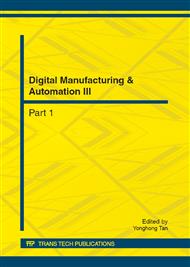p.647
p.651
p.656
p.661
p.666
p.673
p.679
p.683
p.688
Design an Auto-Recharging System for Mobile Robots
Abstract:
The article develops an auto-charging system for mobile robots, and programs a new docking processing to enhance successful rate. The system contains a docking station and a mobile robot. The docking station contains a docking structure, a limit switch, a charger, two power detection modules and two wireless RF modules. The mobile robot contains a power detection module (voltage and current), an auto-switch, a wireless RF module, a charging connection structure and a laser range finder. The docking structure is designed with one active degree of freedom and two passive degrees of freedom. The power detection module is controlled by HOLTEK microchip. We calculate the power values using the redundant management method and statistical signal prediction method, and develop an auto-recharging processing using multiple sensors and laser range finder for mobile robots. The processing can enhances the successful rate to guide the mobile robot moving to the docking station. In the experimental results, the power of the mobile robot is under the threshold value. The mobile robot transmits the charging command to the docking station via wireless RF interface, and searches the landmark of the docking station using laser range finder (SICK). The laser range finder guides the mobile robot approach to the docking station. The mobile robot touches the docking station to trig the power detection device. The docking station supplies the power to the mobile robot by charger, and detects the current and voltage values of the charging processing. The charging current of the docking station is under the threshold value. The docking station turns off the charging current, and trigs the mobile robot leaving the docking station via wireless RF interface.
Info:
Periodical:
Pages:
666-672
Citation:
Online since:
July 2012
Price:
Сopyright:
© 2012 Trans Tech Publications Ltd. All Rights Reserved
Share:
Citation:


